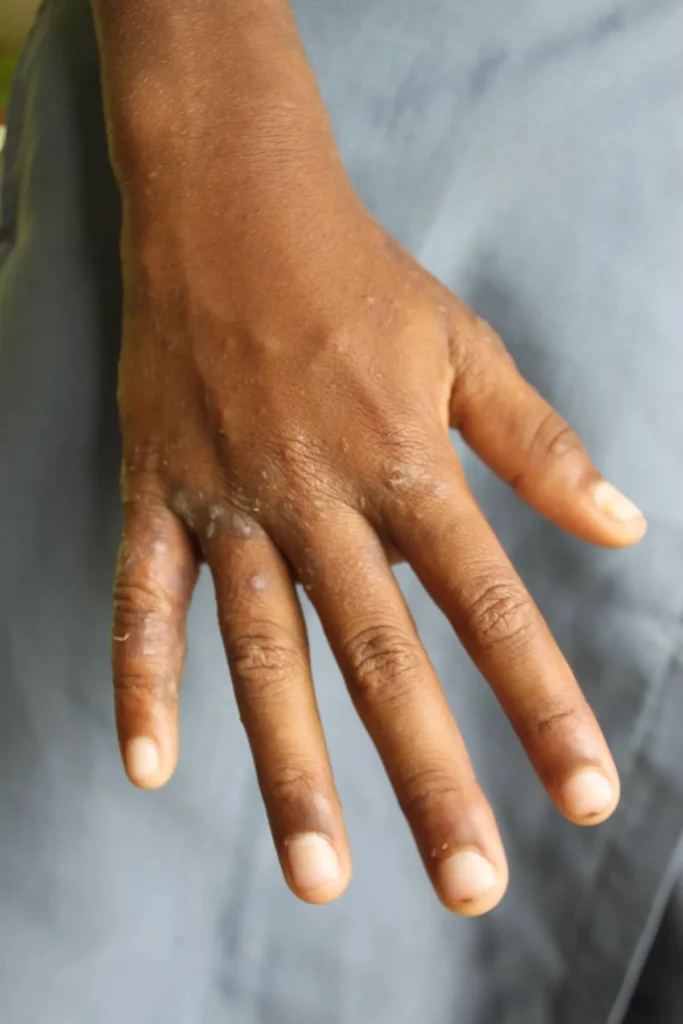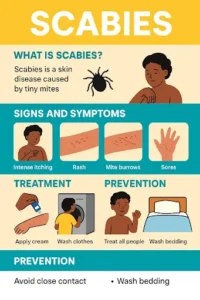Author's details
- Hakim A Abubakre
- BA (Hons) International Business Management, Msc Digital Marketing.
Reviewer's details
- Dr. Khashau Eleburuike
- MBBS (Ilorin) MSc. Global Health Karolinska Institute.
- Resident doctor in family medicine in Northen Sweden.

- Date Published: 2025-08-30
- Date Updated: 2025-08-30
Scabies
What is Scabies?
Scabies is a very common skin disease worldwide, including Sub-Saharan Africa. It is caused by a tiny mite called Sarcoptes scabiei var. hominis.
The mites burrow into the skin to live, feed, and lay eggs, causing intense itching and rash. Scabies spreads mainly through direct skin-to-skin contact, though sharing bedding or clothing can also pass it on.
Scabies is not a sign of poor hygiene. Anyone can be affected, but it is especially common among children, families in crowded homes, schools, prisons, refugee camps, and people with weak immune systems.
Why is Scabies Important?
- Scabies cause severe itching, poor sleep, and difficulty concentrating, which can affect school, work, and quality of life.
- Scratching damages the skin, leading to secondary bacterial infections such as impetigo.
- Repeated or severe infections can lead to serious complications including:
- Sepsis (blood infection)
- Heart disease (rheumatic fever, rheumatic heart disease)
- Kidney disease (post-streptococcal glomerulonephritis), especially in children in tropical, low-resource areas.
Warning Signs and Symptoms
- Severe itching, often worse at night.
- Thin, wavy burrows on the skin (tiny blisters or lines).
- Red rash or small bumps.
- Sores from scratching, which may become infected.
- Thick crusts on the skin (in severe “crusted scabies”).
- Skin discoloration after healing.
Commonly affected areas include the hands, wrists, elbows, armpits, waistline, buttocks, and genital area. In children, scalp, face, palms, and soles may also be affected.
Self-Care and Treatment
Medical Treatment (Scabicides)
Everyone in the household and close contacts should be treated at the same time.
- Permethrin 5% cream – Apply over the whole body from the neck down (and on scalp/face in infants). Leave 8–14 hours, then wash off. Repeat in 7 days.
- Benzyl benzoate lotion (10–25%) – Often available in Africa; may irritate children, so dilute if needed.
- Sulphur ointment (5–10%) – Safe in infants, pregnant women, and breastfeeding mothers.
- Ivermectin tablets – For outbreaks, crusted scabies, or severe cases; repeated after 7–14 days.
Relief of Symptoms
- Apply cool compresses or menthol-based soothing lotions.
- Use calamine lotion or oral antihistamines for itching.
- Doctors may prescribe mild steroid creams (hydrocortisone) or crotamiton to reduce inflammation.
Cleaning the Environment
- Wash bedding, clothes, and towels in hot water (60°C or higher) and dry in the sun or hot dryer.
- Seal un-washable clothes in a plastic bag for at least 3 days to 1 week.
- Cut fingernails short to reduce scratching injuries.
When to See a Health Worker
- If you have symptoms of scabies.
- If there are open sores, pus, or signs of infection.
- If you have a crusted, thick scaly rash.
- If itching continues 2–4 weeks after treatment.
- If you are pregnant, elderly, a baby, or have HIV/weak immunity.
Prevention
- Treat all household members and close contacts at the same time.
- Avoid skin-to-skin contact with untreated people.
- Do not share bedding, clothes, or towels with someone who has scabies.
- Wash and dry household items thoroughly.
- Health education in schools and communities can reduce outbreaks.

Key Messages
- Scabies is common but treatable.
- It spreads quickly in crowded homes, schools, and institutions.
- Proper treatment and cleaning of bedding/clothing stop re-infection.
- Scabies can cause serious complications (heart and kidney disease) if left untreated.
- Seek care early and treat everyone in close contact.
- World Health Organization (WHO). Scabies and Other Ectoparasites. WHO Fact Sheet, 2020.
- Engelman D, et al. The public health control of scabies: strategies for prevention, control and elimination. Trop Med Infect Dis. 2018;3(3):98.
- Marks M, et al. Management of scabies outbreaks in residential and institutional settings in Africa. PLoS Negl Trop Dis. 2017;11(10):e0006012.
- Heukelbach J, Feldmeier H. Scabies. Lancet. 2006;367(9524):1767–1774.
- Romani L, Steer AC, Whitfeld MJ, Kaldor JM. Prevalence of scabies and impetigo worldwide: a systematic review. Lancet Infect Dis. 2015;15(8):960–967.
